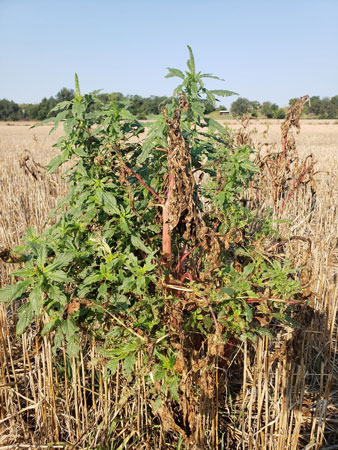This growing season has resulted in more than the usual discussion regarding weed management in wheat. That conversation continues, as we think about what happens when we remove the crop canopy. Weeds that have been suppressed by the canopy will grow rapidly once crop competition is removed. In addition, weeds that have emerged through the wheat canopy will be damaged during harvest and will quickly begin regrowth. Delaying control can result in lost soil moisture that could be used for crop production, as well as weed seed production which will cause difficulties in the future.
When thinking about weed control in wheat stubble, there are two priorities – controlling already emerged weeds and preventing later flushes. Making applications before weeds exceed 4 to 6 inches is necessary for good control of already emerged weeds (Figure 1). Residual herbicides are needed to reduce the number of herbicide applications needed to control multiple flushes of weeds.

Figure 1. This large Palmer amaranth is regrowing after being sprayed with paraquat. Photo by Sarah Lancaster, K-State Research and Extension.
Despite a growing number of herbicide-resistant weeds, glyphosate plus 2,4-D LVE and/or dicamba continue to be important for weed control in wheat stubble. However, these herbicides alone are not likely to provide adequate control of pigweeds or kochia, especially when applied in the hot, dry conditions that are common after wheat harvest. The following paragraphs will list some herbicide options commonly used to control weeds after wheat harvest.
Paraquat (Gramoxone, others) is one herbicide that can work well in place of glyphosate to control emerged pigweed and kochia. Paraquat is a contact herbicide, so spray coverage is critical. Spray volumes of 20 gallons/acre or higher are preferred, especially on larger weeds or denser stands. Paraquat needs to be applied with a non-ionic surfactant or oil concentrate to enhance the surface coverage of the plant foliage. Also, remember there is a requirement for handlers and applicators to be certified to use paraquat (training information is included at the end of this article).
If planning to plant corn or sorghum next spring, a tank mix of paraquat with atrazine will enhance the control of emerged weeds and provide some residual weed control. However, it is important to be aware of the total amount of atrazine you are applying to each field in a given year. Metribuzin can be used instead of atrazine if rotating to soybean to enhance control and provide some residual activity.
One final note regarding paraquat. Limited research out of Australia suggests applying paraquat 2 weeks after a glyphosate application will increase weed control. This is called a ‘double knock’ strategy. I include this information here not as a recommendation per se, but to encourage careful thought about when you want to utilize contact herbicides in your fallow weed management system.
Saflufenacil (Sharpen) applied at one to two fluid ounces per acre is an option to provide postemergence and short-term residual control of Palmer amaranth, kochia, and other broadleaf weeds. Sharpen should be applied with glyphosate for grass control, and can be applied with other products labeled for use in wheat stubble, but do not apply Sharpen with Valor. Sharpen works best with the addition of methylated seed oil and ammonium sulfate. Good spray coverage is needed, so using 15 to 20 gallons/acre spray solution is important. Be sure to note crop rotation intervals for your situation, especially if using more than one fluid ounce per acre or applying to sandy or low organic matter soils.
Flumioxazin (Valor, others) can be added to burndown treatments at rates of one to four fluid ounces per acre for activity on emerged broadleaf weeds and some residual activity on broadleaf and grass weeds in wheat stubble. Flumioxazin can be mixed with glyphosate or clethodim (Select Max) for enhanced grass control. It can also be mixed with 2,4-D, atrazine, metribuzin, or paraquat. Wheat can be planted 30 days after two fluid ounces per acre, or 60 days after three fluid ounces per acre if at least one inch of rain occurs between application and planting. Soybeans can be planted immediately after an application of three fluid ounces per acre. Corn, sorghum, cotton, sunflowers, or soybeans can be planted in the spring following the application of four fluid ounces per acre. Residual weed control with flumioxazin will depend on rainfall (0.25 inch) for activation, just as with pre-plant treatment in soybeans.
Flumioxazin has longer residual activity than saflufenacil (Sharpen), however, saflufenacil provides greater control of kochia than flumioxazin. A third Group 14 product that could be used is tiafenacil (Reviton). Similar to saflufenacil, it requires both MSO and AMS as adjuvants and should be applied with glyphosate for grass control.
For more detailed information, see the “2023 Chemical Weed Control for Field Crops, Pastures, and Noncropland” guide available online at https://www.bookstore.ksre.ksu.edu/pubs/CHEMWEEDGUIDE.pdf or check with your local K-State Research and Extension office for a paper copy.
Paraquat training
If you have not completed the certification for applying or handling paraquat, here is a link to the training: http://usparaquattraining.com/ Additional details in the January 12, 2023 eUpdate: https://eupdate.agronomy.ksu.edu/article_new/2023-kansas-training-information-for-paraquat-and-dicamba-526-1
The use of trade names is for clarity to readers and does not imply endorsement of a particular product, nor does exclusion imply non-approval. Always consult the herbicide label for the most current use requirements.
Sarah Lancaster, Weed Science Extension Specialist
slancaster@ksu.edu
Jeanne Falk Jones, Multi-County Agronomist
jfalkjones@ksu.edu
Tags: weed control wheat post-harvest